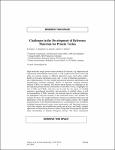Challenges in the Development of Reference Materials for Protein Toxins
Zeleny, Reinhard
Rummel, Andreas
Jansson, Daniel
Dorner, Brigitte
High molecular weight protein toxins produced by bacteria, e.g. staphylococcal
enterotoxins and botulinum neurotoxins, as well as plant toxins such as ricin and
abrin, are relevant analytes in different application areas: food safety, public
health, civil security and defense sector, and – in case of botulinum neurotoxins –
also in pharmaceutics. For their reliable and accurate detection, identification and
quantification, reference materials (RMs), in particular certified reference
material (CRM), are required. The present article focuses on challenges in the
development (production and certification) of such RMs. Firstly, it highlights the
role of RMs and CRMs, what they can be used for, the nature of certified
properties, metrological traceability, and uncertainty of certified values, as well
as commutability of RMs. Secondly, the molecule-specific technical challenges
are highlighted using the example of the mentioned toxins. This includes for
instance the choice of a suitable purification strategy (recombinant expression and
purification versus the purification of toxin from natural sources), the in-depth
characterization of the obtained preparations by a comprehensive set of methods
including immunochemical assays, mass spectrometry, and functional assays to
verify their identity and establish their purity and activity, and finally, suitable
approaches for determining reference values of important toxin properties (protein
mass concentration in solution, biological activity). The article summarizes ongoing activities in a new European initiative called EuroBioTox, which aims at
the production and certification of RMs for selected protein toxins and the
establishment of validated procedures for the detection and identification of
biological toxins.
Dateien zu dieser Publikation
Keine Lizenzangabe

